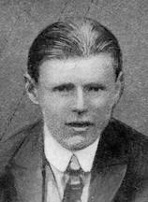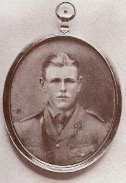Lionel Holford Hughes

| Rank: | Second Lieutenant |
| Regiment: | North Staffordshire Regiment, 3rd Batallion, attached 1st Batallion |
| Country: | France |
| Cemetary/Memorial: | Ration Farm Military Cemetary, La Chapelle-D’Armentieres, Special Memorial near VI.M. |
| Awards: | 1914 Star British War Medal Victory Medal |
Born on 25th July 1895 at Wychdon Lodge near Stafford, Second Lieutenant Hughes died in action in France on 29th October 1914, aged 19.
He was the only son of Allen Edward Hughes (1866-1916), an earthenware manufacturer, and Evelyn Emma Hughes (nee Plant, 1868-1945) of Wychdon Lodge, Weston in Staffordshire and of "Cintra", Budleigh Salterton in Devon. He had two younger sisters, Eleanor Antoinette (b.1897) and Josephine Mary (b. 1899) who went on to study at Malvern College for Girls.
He joined Saint Ronan’s in the Autumn of 1904 and at the end of his first term won the Form prize. In 1905 he won prizes for English and French.
In football he “showed promise, but must learn to keep his place.” He was a member of the 3rd Cricket XI in 1905, when his play was noted as being “particularly good”. He went on to join the 1st Cricket XI in 1909 when the Ronina recorded him as “A very useful bat, with some nice shots; he may in time make a good bowler." He returned to visit Saint Ronan’s in the Autumn of 1909 and again in 1910.
In September 1909 Lionel went on to Lancing College where he won an Exhibition and was in Seconds House. His departure from Saint Ronan’s was reported: “his loss will be keenly felt on the cricket and football field, and his happy, pleasant presence will be universally missed”.
He was a Cadet Officer in the Officer Training Corps, achieving Certificate A and was a member of the Shooting VII in 1912 and 1913. He was a member of the Cricket XI in 1913 and of the Running Team the same year. He played 2nd XI football in 1912/13 and for the 1st XI in 1913. He was Captain of Running in 1912 and 1913. He represented the school at Bisley for two years, won the School Mile and the Steeplechase in 1913 as well as coming second in the Five Mile. He was appointed as a House Captain and as a Librarian in September 1912 and as a Prefect in September 1913. He was also Head of House. He also spoke regularly at the Debating Society. He achieved his School Certificate in 1913, leaving the school in December of the same year.
While still at Lancing he was commissioned as a Second Lieutenant in the 3rd Battalion North Staffordshire Regiment, Special Reserve of Officers on 26th April 1913.
He was transferred to the 1st Battalion North Staffordshire Regiment as a Second Lieutenant on 6th March 1914 and spent some time training in Ireland.
Following the outbreak of war he landed in France on 21st September 1914 leading the first draft of 100 replacements for the 1st Battalion.
On completion of this task he did not return to England, but spent the next month at a base before joining his battalion in the field on 27th October where they were in billets at Fleurbaix.
The following day the battalion relieved the 1st Battalion East Yorkshire Regiment in trenches at Rue du Bois and spent the day attempting to remove the large number of German bodies which had built up in front of the trench. On 29th October 1914, Lionel Hughes was killed by a stray shell.
The diary entry of an unknown non-commissioned officer from “D” Company for the day reads:
"Heavy shelling all day. Lieutenant Hughes, who has only been with us four days, killed. I had just given him a cup of tea, and he returned to his tunnel when he was hit by a shell, which also killed Private Dewsbury and wounded Sergeant Rushton."
Second Lieutenant Hughes’ father received the following telegram, dated 4th November 1914:
"Deeply regret to inform you that 2nd Lieut. L.H. Hughes N. Staffs Regt. was killed 30-31 October. Lord Kitchener expresses his sympathy."
His Ronian obituary reads “Hughes was at S. Ronan’s from 1904 – 09, and is therefore one of the youngest victims of the war. He was killed in the trenches by shrapnel. We cannot do better than print, first, his Colonel’s letter to his mother, and secondly, the extract from the Magazine of his Public School. Nothing could better express our own feelings, or our pride that a S. Ronan’s boy could be so spoken of. We often saw him as he frequently came over from Lancing to visit us, and the “Canary–bird” as he was affectionately called on account of his fair hair, was a favourite with us”.
His Commanding Officer, Lieutenant Colonel Vigant William de Falbe DSO wrote:
“He was killed today by a shell in the trenches near Rue du Bois, a small village two miles south of Armentieres. He was killed instantaneously, and is buried on the west side of the Armentieres-Wavrin Railway, and 300 yards north west of the level crossing at Rue du Bois. The grave is marked with a cross inscribed with his name and regiment and there should be no difficulty in identifying it.”
From the Adjutant, North Raglan Barracks, Devonport:
“It was a terrible shock to all of us to hear of your son’s death as we were all so fond of him and he was such a cheerful companion and a real hard worker… he was genuinely popular.”
 He is commemorated on the war memorial at St Peter's Church, Hixon, Staffordshire, on the war memorial at Berkswich, North Staffordshire and on the Dover war memorial. He is also commemorated on the memorial at Budleigh Salterton, Devon and on the memorial at St Ronan's School. He is remembered on his father’s grave at St Peter’s Church, Moor Land, Budleigh Salterton.
He is commemorated on the war memorial at St Peter's Church, Hixon, Staffordshire, on the war memorial at Berkswich, North Staffordshire and on the Dover war memorial. He is also commemorated on the memorial at Budleigh Salterton, Devon and on the memorial at St Ronan's School. He is remembered on his father’s grave at St Peter’s Church, Moor Land, Budleigh Salterton.
